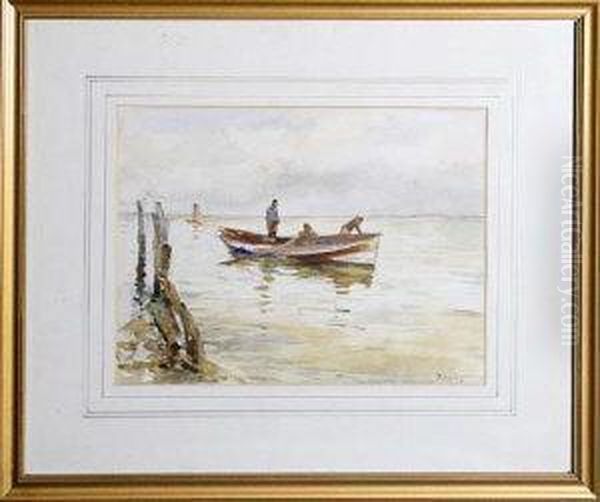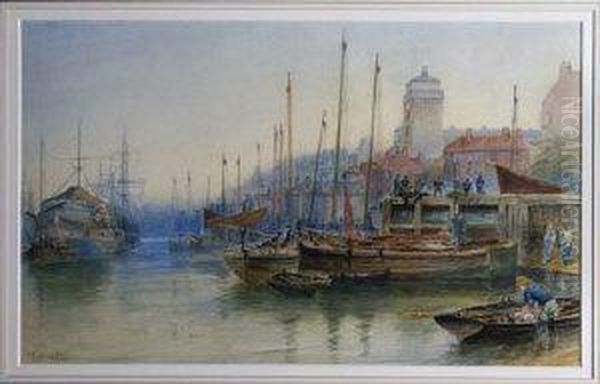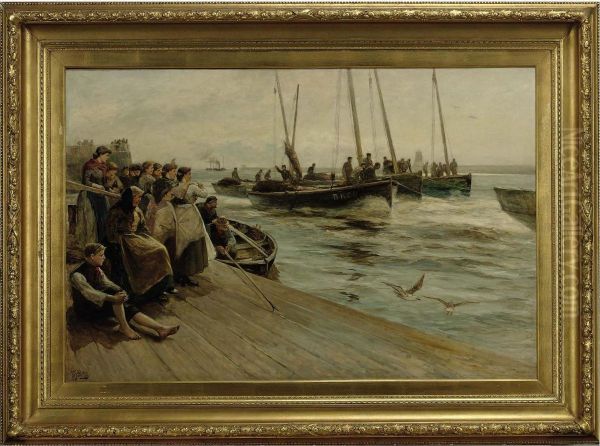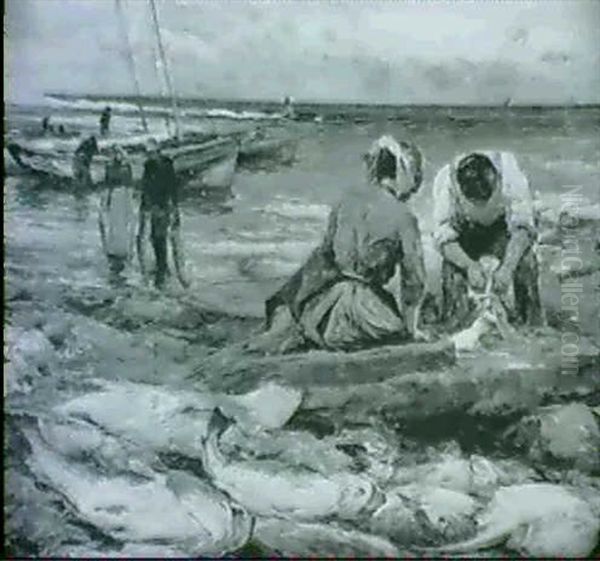
Robert Jobling (1841–1923) stands as a significant figure in British regional art, particularly renowned for his evocative depictions of life and landscape along the North East coast of England. Working primarily in oil and watercolour, Jobling captured the rugged beauty of the coastline, the daily toil of fishing communities, and the distinctive atmosphere of Northumbrian light. His association with the Staithes group of artists and his regular exhibitions at prestigious institutions like the Royal Academy cemented his reputation during his lifetime, a reputation that endures through the continued appreciation of his work.
Early Life and Artistic Formation
Born in Newcastle-upon-Tyne in 1841, Robert Jobling's early career path was practical rather than purely artistic. He initially worked in trades related to painting, such as house painting and decorating, and later found employment at the Tyne shipbuilding firm of Messrs. T. & W. Smith, painting ships' figureheads. This grounding in practical application likely honed his observational skills and understanding of form, providing a solid, albeit unconventional, foundation for his later fine art pursuits.
His formal art education took place at the Newcastle School of Art, where he studied under William Bell Scott. Scott, a poet and painter associated with the Pre-Raphaelite Brotherhood, would have instilled in his students the importance of close observation of nature and detailed rendering. This influence can be discerned in Jobling's later commitment to realism and his meticulous attention to the specifics of place, atmosphere, and human activity. His early works, such as A Winter's Morning on the Tyne (1874), demonstrate his connection to his native Tyneside and his ability to capture the industrial, as well as the natural, landscape.
The Lure of the Coast: Cullercoats
During the latter half of the 19th century, the fishing village of Cullercoats, near Tynemouth, became a magnet for artists. Its picturesque harbour, traditional fishing methods, distinctive fisherfolk attire (particularly the 'Cullercoats fishwives'), and the quality of the coastal light attracted painters seeking authentic, unvarnished subjects. The American master Winslow Homer famously spent time there in 1881-1882, producing powerful watercolours and oils that captured the stoicism and drama of life by the sea.

Robert Jobling was deeply involved with the Cullercoats artists' colony. He found rich subject matter in the village's daily rhythms – the launching and landing of the fishing boats (cobles), the mending of nets, the selling of fish, and the quiet moments of domestic life set against the backdrop of the North Sea. His time in Cullercoats was formative, allowing him to develop his characteristic style, marked by strong contrasts of light and shadow, vibrant colour, and an empathetic portrayal of the local community. Artists like John Falconar Slater also frequented Cullercoats, contributing to a vibrant local artistic scene.
Staithes: A Haven for Realism
Further up the coast, nestled in a steep ravine on the edge of the North York Moors, lay the fishing village of Staithes. Even more rugged and perhaps less self-consciously picturesque than Cullercoats, Staithes offered artists a powerful sense of raw, untamed nature and a community deeply intertwined with the sea. By the late 1880s and 1890s, it became the centre for what is now known as the Staithes Group or Staithes Art Club.
Jobling was a key member of this informal group of artists who were drawn to the village's dramatic cliffs, bustling harbour (known as 'The Beck'), and the challenging, often perilous, lives of its inhabitants. Like the Newlyn School artists working contemporaneously in Cornwall (such as Stanhope Forbes and Walter Langley), the Staithes painters generally favoured realism and naturalism, often working en plein air (outdoors) to capture the fleeting effects of light and weather. They sought authenticity, depicting the working lives of the fisherfolk without excessive sentimentality, focusing on the dignity of labour and the community's resilience.
The Staithes Group: Contemporaries and Colleagues
The Staithes Group was not a formal institution with manifestos, but rather a loose association of artists united by their shared location and artistic interests. Robert Jobling worked alongside a talented generation of painters in the village. Among the most prominent were Laura Knight and her husband Harold Knight, who spent significant periods in Staithes early in their careers, capturing the local characters and coastal scenes with burgeoning modernist sensibilities.
Other notable members included Jobling's own wife, Isabella Jobling (née Thompson), herself an accomplished painter specializing in interiors and genre scenes featuring the women and children of Staithes. Frederick William Jackson was another long-term resident and influential figure. Artists such as Arthur Friedenson, Joseph R. Bagshawe (known for his marine paintings), Owen Bowen, Mark Senior, James William Booth, Rowland Henry Hill, Ernest Dade (another fine marine painter), and Albert George Stevens were all part of this vibrant artistic milieu, contributing to a distinctive regional school of painting focused on the North Yorkshire coast.
Jobling's Artistic Vision: Light, Labour, and Landscape

Robert Jobling's mature style is characterized by its robust realism, sensitivity to atmosphere, and focus on the interplay of light and shadow. He excelled at capturing the specific conditions of the North Sea coast – the bright, clear light of a summer's day, the diffused glow of twilight over the harbour, the harsh glare on wet sand, or the brooding skies of an impending storm. His palette could be vibrant, reflecting the colourful fishing boats and clothing, but also subtly modulated to convey mood and weather.
His subject matter consistently revolved around the sea and the lives bound to it. Fishermen launching their cobles, women baiting lines or carrying baskets (creels) of fish, children playing on the shore, and the boats themselves, whether at sea or drawn up on the beach, were recurring themes. Works like Fishermen in a Coble (1896) exemplify his focus on the traditional fishing craft and the skilled men who sailed them. He treated his subjects with respect, portraying their labour and resilience without romanticizing the hardships they faced. His work provides a valuable visual record of a coastal way of life that was already beginning to change.
Masterworks: Capturing Coastal Life
Several paintings stand out as representative of Jobling's achievement. Darkness Falls from the Wings of Night (1886) is perhaps his most famous work. Exhibited at the Royal Academy, its title quotes Henry Wadsworth Longfellow's poem "The Day is Done". The painting depicts the end of the working day in a fishing village, likely Cullercoats or Staithes. Figures return home as dusk settles, lights begin to appear in windows, and a palpable sense of quiet descends. Jobling masterfully handles the fading natural light and the emerging artificial light, creating a scene rich in atmosphere and quiet human drama.
Going out on the Tide (also known as Going Out on the Tide - The Beck Staith) captures the energy and purpose of fishermen preparing to set sail. It likely depicts the bustling activity within the confines of Staithes harbour, emphasizing the communal effort and the inherent risks of heading out to sea. The painting showcases Jobling's ability to render complex scenes with numerous figures and boats, conveying a strong sense of movement and place.
His earlier work, A Winter's Morning on the Tyne (1874), shows his versatility and connection to the industrial heartland of the North East. It captures a different kind of atmosphere – perhaps colder, grittier, reflecting the industrial activity of the river. Other notable works include The Quayside (1892), Staithes Girls (1910), The Fishing Boat (1886), and The Mill, demonstrating his consistent engagement with the landscapes and people of his region throughout his long career.
Recognition and Professional Life

Robert Jobling achieved considerable recognition during his lifetime. His work was accepted for exhibition at the prestigious Royal Academy in London, as well as the Royal Society of British Artists (RBA), from at least 1883 onwards. This national exposure indicates the quality and appeal of his paintings beyond his home region.
Locally, Jobling was a prominent figure in the Newcastle art scene. He was a co-founder of the Bewick Club, established in 1883 alongside Humphrey Emmerson and others. Named in honour of the great Northumbrian wood engraver Thomas Bewick, the club aimed to encourage and exhibit the work of local artists, providing a vital platform and social hub. Jobling's involvement underscores his commitment to fostering artistic talent in the North East. His paintings were also sometimes used to illustrate publications on local history and lore, such as the Monthly Chronicle of North-country Lore and Legend, embedding his work within the cultural fabric of the region.
Isabella Jobling: An Artistic Partnership
It is important to note that Robert Jobling's wife, Isabella Jobling (née Thompson, 1851-1926), was also a respected artist and a member of the Staithes Group. While Robert often focused on the outdoor life and marine scenes, Isabella became known for her sensitive portrayals of domestic interiors, often featuring the women and children of the fishing community. Her work complements Robert's, offering a different perspective on life in Staithes. They shared an artistic life, working in the same environment and exhibiting alongside each other, forming a notable artistic partnership within the North East art world.
Legacy and Reputation
Robert Jobling's legacy lies in his powerful and authentic portrayal of the Northumbrian and North Yorkshire coast and its people during a period of significant social and economic change. He stands as one of the leading figures of the Staithes Group and a major North Eastern artist of his generation. His work avoided the sentimentality sometimes found in Victorian genre painting, opting instead for a more direct, observational approach that captured both the beauty and the harshness of coastal life.

His paintings continue to be sought after, appearing regularly at auction and held in public collections, particularly in the North East of England. They are valued not only for their artistic merit – his skillful handling of light, colour, and composition – but also as historical documents, recording the fishing communities, their traditional boats, and their way of life with accuracy and empathy. While perhaps not engaging with the radical modernist developments emerging elsewhere in Europe with artists like Claude Monet or Vincent van Gogh, Jobling's commitment to realism and his deep connection to his chosen subject matter resulted in a body of work that remains compelling and significant within the context of British art. He was, in essence, a visual historian of his region.
Conclusion
Robert Jobling dedicated his artistic career to capturing the essence of the North East coast of England. From the industrial Tyne to the fishing villages of Cullercoats and Staithes, he observed and recorded the landscape, the sea, and the people with a keen eye and a sympathetic understanding. His mastery of light and atmosphere, combined with his realistic depiction of labour and community, marks him as a crucial figure in Northumbrian art history. As a prominent member of the Staithes Group and a respected exhibitor on the national stage, Jobling created an enduring legacy, leaving behind a rich visual chronicle of a unique time and place.